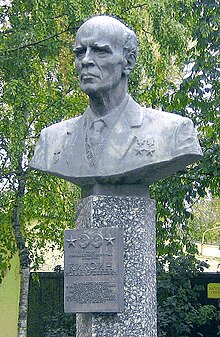Biography
Kikoin was born in the town of Novye Zhagory (now Žagarė in Lithuania), Russian Empire, in a Lithuanian Jewish family; his parents, Kushel Isaakovich and Bunya Israilevna, were school teachers. During the World War I, his family was relocated from Latvia to Russia where he entered in gymnazium in Pskov, and upon graduation, he went to study physics at the Leningrad Polytechnic Institute in 1925.
In 1930-31, he earned his specialist degree in physics and successfully defended his thesis on Photomagnetism for his Doktor Nauk in 1936. He taught physics at the Leningrad Polytechnic Institute, and his early work investigated the electrical conductivity and magnetic attractions in metals until 1938. From 1938 till 1944, he taught physics at the Ural Polytechnic Institute and found a landmine project with the Red Army that would demagnetize, and detonate the German army's tanks.: 412 It was Kurchatov who brought Kikoin in Soviet program of nuclear weapons and assigned him the Uranium enrichment project at this Laboratory No. 2 using the gaseous diffusion method took place under Kikoin while Lev Artsimovich worked on electromagnetic isotope separation.: 78 During the Russian Alsos, he went to Germany to locate German knowledge that would prove useful in Soviet programs.: 24
He remained associate with Soviet program of nuclear weapons, and was an academician of the Academy of Sciences of the Soviet Union and was awarded the Stalin Prize a total of four times (1942, 1949, 1951, 1953), the Lenin Prize in 1959, and the USSR State Prize in 1967 and 1980. Kikoin was named a Hero of Socialist Labour (1951); he also won the Kurchatov Medal (1971). Kikoin was with Igor Kurchatov as one of the founders of the Kurchatov Atomic Energy Institute, which developed the first Soviet nuclear reactor in 1946. This was the lead-in to the Soviet atomic bomb project with the first atomic bomb test taking place in 1949.
In 1970, Kikoin (jointly with Andrey Kolmogorov) started issuing Kvant magazine, a popular science magazine in physics and mathematics for school students and teachers. He authored texts on molecular physics in 1978, and it has been translated in Persian language.
